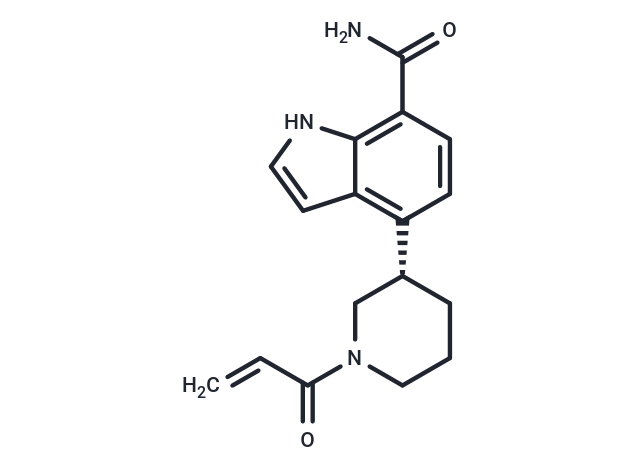- 全部删除
 您的购物车当前为空
您的购物车当前为空
购物车
Elsubrutinib
产品编号 T39130Cas号 1643570-24-4
别名 ABBV-105
Elsubrutinib (ABBV-105) is a highly active, potent, and selective orally-administered inhibitor of Bruton's tyrosine kinase (BTK). It irreversibly inhibits the catalytic domain of BTK with an IC50 value of 0.18 μM. Elsubrutinib holds potential for the advancement of research on inflammatory diseases.

Elsubrutinib
产品编号 T39130 别名 ABBV-105Cas号 1643570-24-4
Elsubrutinib (ABBV-105) is a highly active, potent, and selective orally-administered inhibitor of Bruton's tyrosine kinase (BTK). It irreversibly inhibits the catalytic domain of BTK with an IC50 value of 0.18 μM. Elsubrutinib holds potential for the advancement of research on inflammatory diseases.
| 规格 | 价格 | 库存 | 数量 |
|---|---|---|---|
| 2 mg | ¥ 4,190 | 5日内发货 |
大包装 & 定制
加入购物车
TargetMol 的所有产品仅用作科学研究或药证申报,不能被用于人体,我们不向个人提供产品和服务。请您遵守承诺用途,不得违反法律法规规定用于任何其他用途。
联系我们获取更多批次信息
资源下载
产品介绍
生物活性
化学信息
| 产品描述 | Elsubrutinib (ABBV-105) is a highly active, potent, and selective orally-administered inhibitor of Bruton's tyrosine kinase (BTK). It irreversibly inhibits the catalytic domain of BTK with an IC50 value of 0.18 μM. Elsubrutinib holds potential for the advancement of research on inflammatory diseases. |
| 靶点活性 | BTK:0.18 μM (IC50) |
| 体外活性 | Elsubrutinib inhibits BTK (C481S) with an IC 50 of 2.6 μM, indicating a significant loss in potency upon exchanging the targeted thiol nucleophile with an alcohol, suggesting Cys481 is important in the manner in which Elsubrutinib inhibits BTK. Elsubrutinib irreversibly inhibits BTK enzyme activity and blocks BTK-dependent cellular activation. Elsubrutinib inhibits histamine release from IgE-stimulated basophils and IL-6 release from IgG-stimulated monocytes, which utilize Fce and Fcc receptors respectively. Elsubrutinib inhibits IgM-mediated B cell proliferation, which is dependent on signaling through the BCR. Elsubrutinib also inhibits TNF-release from CpG-DNA stimulated PBMCs, which signals through TLR9, although it does not inhibit the function of TLRs that do not use ITAM motifs, namely, TNF release from PBMCs stimulated either through TLR4 (with LPS) or through TLR7/8 (with R848). Elsubrutinib has significant impacts on IgM-mediated B cell proliferation[1]. |
| 体内活性 | Elsubrutinib (10 mg/kg; p.o.) inhibits antibody responses to NP-Ficoll and NP-KLH, but not to NP-LPS or Prevnar-13[1]. Elsubrutinib (0.1~10 mg/kg; p.o.) results in dose-dependent inhibition of paw swelling throughout the course of disease and significantly prevents the onset of proteinuria and prolongs survival at the 10 mg/kg QD and BID doses, while lower doses does not significantly inhibit these endpoints[1]. Elsubrutinib demonstrates exposure-dependent inhibition of increases in paw volume. Elsubrutinib significantly inhibits bone volume loss in a dose dependent manner consistent with the observed anti-inflammatory effects[1]. Animal Model: Female C57/BL6 mice[1]Dosage: 10 mg/kg Administration: P.o. Result: Inhibited antibody responses to NP-Ficoll and NP-KLH, but not to NP-LPS or Prevnar-13. Animal Model: Lewis rats[1]Dosage: 0.1~10 mg/kg Administration: P.o. Result: Resulted in dose-dependent inhibition of paw swelling throughout the course of disease. Animal Model: NZBWF1 mice[1]Dosage: 0.1~10 mg/kg Administration: P.o. Result: Significantly prevented the onset of proteinuria and prolonged survival at the 10 mg/kg QD and BID doses, while lower doses did not significantly inhibit these endpoints. |
| 别名 | ABBV-105 |
| 分子量 | 297.358 |
| 分子式 | C17H19N3O2 |
| CAS No. | 1643570-24-4 |
储存&溶解度
| 存储 | Powder: -20°C for 3 years | In solvent: -80°C for 1 year | Shipping with blue ice. |
SCI 文献
计算器
体内实验配液计算器
请在以下方框中输入您的动物实验信息后点击计算,可以得到母液配置方法和体内配方的制备方法:
剂量转换
对于不同动物的给药剂量换算,您也可以参考 更多
评论列表
Related Tags: buy Elsubrutinib | purchase Elsubrutinib | Elsubrutinib cost | order Elsubrutinib | Elsubrutinib chemical structure | Elsubrutinib in vivo | Elsubrutinib in vitro | Elsubrutinib formula | Elsubrutinib molecular weight





 还可以
还可以

评论内容